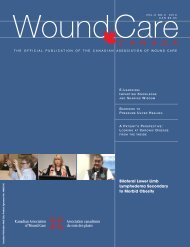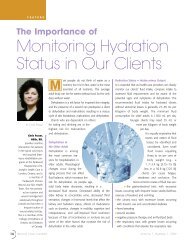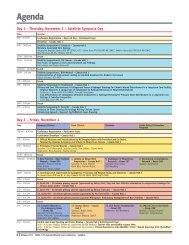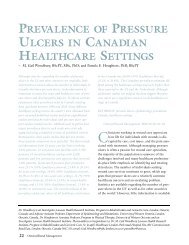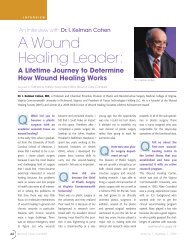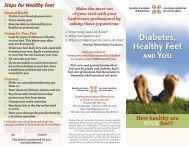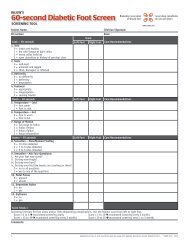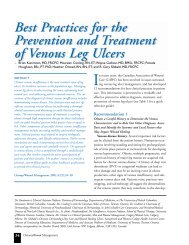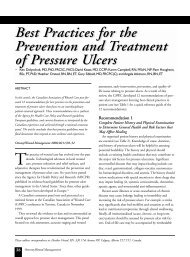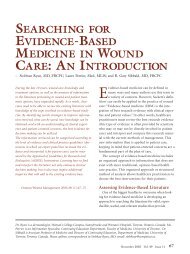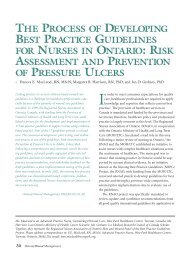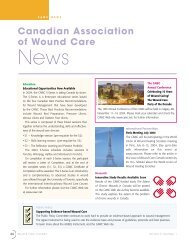Preparing the Wound Bed – Debridement, Bacterial Balance, and ...
Preparing the Wound Bed – Debridement, Bacterial Balance, and ...
Preparing the Wound Bed – Debridement, Bacterial Balance, and ...
Create successful ePaper yourself
Turn your PDF publications into a flip-book with our unique Google optimized e-Paper software.
Recommendation 6<br />
Assess <strong>the</strong> <strong>Wound</strong> for <strong>Bacterial</strong> <strong>Balance</strong> <strong>and</strong><br />
Infection<br />
The presence of wound-associated bacteria alone does not<br />
indicate infection or impaired wound healing. Indeed, some<br />
authors have suggested that a small amount of a certain bacteria<br />
species in a chronic wound facilitates healing. 29,30 In<br />
clinical practice, assessing when a wound has moved from a<br />
symbiotic bacterial load that does not cause tissue damage to<br />
an increased bioburden causing impairment of wound healing<br />
can be difficult. The following equation demonstrates<br />
that although bacterial quantity <strong>and</strong> virulence are significant<br />
in assessing a wound for infection, host factors are of overriding<br />
importance.<br />
Risk of wound infection 31 = <strong>Bacterial</strong> dose x virulence<br />
Host resistance<br />
Factors such as immunosuppression, diabetes, <strong>and</strong> medication<br />
all can influence whe<strong>the</strong>r any bacteria present will<br />
impair wound healing. Fur<strong>the</strong>rmore, <strong>the</strong>se factors can act to<br />
mask classical signs of infection such as ery<strong>the</strong>ma, increased<br />
temperature, pain, <strong>and</strong> edema.<br />
Swab technique is important to obtain meaningful<br />
results. 32 The wound should be cleansed with saline or water<br />
<strong>and</strong> all debris should be removed. The healthy appearing<br />
granulation is swabbed in a zigzag pattern, gently rotating<br />
<strong>the</strong> tip of <strong>the</strong> swab (swabs are only recommended if clinically<br />
indicated). If <strong>the</strong> wound is relatively dry, <strong>the</strong> swab may be<br />
moistened with <strong>the</strong> transport media prior to swabbing. A<br />
semiquantitative swab is <strong>the</strong>n inoculated on st<strong>and</strong>ard media<br />
in <strong>the</strong> lab <strong>and</strong> streaked in four quadrants. Results will indicate<br />
no growth to 1 to 4+ growth of an organism, depending<br />
on <strong>the</strong> number of streaked quadrants that support bacterial<br />
growth. These swabs are quick <strong>and</strong> inexpensive. The<br />
semiquantitative swab correlates well to <strong>the</strong> gold st<strong>and</strong>ard<br />
quantitative biopsy results, 33 but <strong>the</strong>re is some loss of specificity.<br />
Despite <strong>the</strong> fact this is <strong>the</strong> procedure of choice in<br />
most centers, inadequate wound bed preparation will result<br />
in an excess number of confusing, nonsignificant wound<br />
surface colonies appearing on <strong>the</strong> agar plates in <strong>the</strong> lab. The<br />
clinical assessment of wound bioburden <strong>and</strong> <strong>the</strong> choice <strong>and</strong><br />
route of antibacterial agents should be based on host <strong>and</strong><br />
wound factors in association with wound swab results.<br />
The concepts of bacterial contamination, colonization,<br />
critical colonization, <strong>and</strong> local <strong>and</strong> systemic infection lend<br />
<strong>the</strong>mselves to guidance with regard to when to use antimicrobial<br />
agents in wound care (see Table 5).<br />
Most wounds are contaminated <strong>and</strong> contain nonreplicat-<br />
24 Ostomy<strong>Wound</strong> Management<br />
ing organisms. Colonization occurs when organisms are<br />
replicating but not causing host injury. Skin commensals<br />
such as Staphylococcus epidermidis <strong>and</strong> Corynebacterium<br />
species are <strong>the</strong> most common colonizers. Nei<strong>the</strong>r contaminated<br />
nor colonized wounds show signs of infection, <strong>and</strong><br />
impairment of wound healing is unlikely. The concept of<br />
critical colonization (increased bacterial burden) has recently<br />
been introduced to describe wounds moving between <strong>the</strong><br />
spectrums of colonization (where <strong>the</strong> host is unaffected) <strong>and</strong><br />
local infection (in which host injury occurs). It has been<br />
suggested that during critical colonization, subtle clinical<br />
signs of infection such as increasing pain/tenderness, increasing<br />
serous exudate <strong>and</strong> friable granulation tissue, or failure<br />
to heal may be present prior to <strong>the</strong> classical signs of foul<br />
odor, frank pus, surrounding ery<strong>the</strong>ma, increased temperature,<br />
pain, <strong>and</strong> swelling associated with infection. 34 It is<br />
important to emphasize that many people with chronic<br />
wounds, in particular people with diabetes, have an<br />
impaired host response. These patients may <strong>the</strong>refore exhibit<br />
only subtle signs, or even have a complete absence of signs<br />
of infection (ie, no elevation in temperature) when bacteria<br />
are damaging <strong>the</strong> skin <strong>and</strong> delaying healing. 35 A semiquantitative<br />
swab with 4+ growth of a significant pathogen or a<br />
quantitative biopsy with ≥ 1.0 x 10 6 cfu/g (cfu = colony<br />
forming unit) of tissue in <strong>the</strong> presence of nonhealing may be<br />
an indication for systemic antibacterial <strong>the</strong>rapy. Therefore,<br />
host monitoring is a vital part of assessment, with factors<br />
such as raised blood sugar levels in people with diabetes<br />
often being a helpful indicator of local or systemic infection.<br />
Recommendation 7<br />
Cleanse <strong>Wound</strong>s with Normal Saline or Water. The<br />
Use of Topical Antiseptics Should be Reserved for<br />
<strong>Wound</strong>s that are Nonhealable or <strong>the</strong> Local <strong>Bacterial</strong><br />
Burden is a Greater Concern than <strong>the</strong> Stimulation<br />
of Healing<br />
Cleansing <strong>and</strong> irrigation are used to eliminate exudate<br />
<strong>and</strong> surface debris from wounds. Not only does this process<br />
facilitate healing, but it also decreases bacterial burden by<br />
removing heavily contaminated surface slough <strong>and</strong> debris.<br />
Saline or sterile water are agents of choice for most<br />
wounds. Tap water should not be used for immunosuppressed<br />
patients <strong>and</strong> <strong>the</strong> water source should be reliably<br />
clean before advocating it as treatment in o<strong>the</strong>r chronic<br />
wounds. 36<br />
Rodeheaver 28 studied wound cleansers in vitro to assess<br />
cellular toxicity. He concluded that nonionic agents are best,



